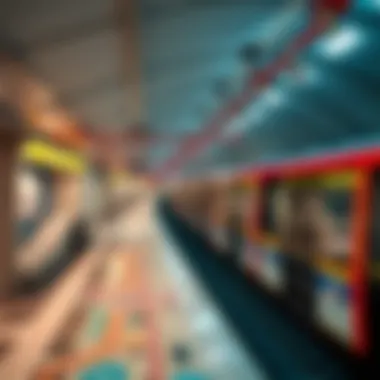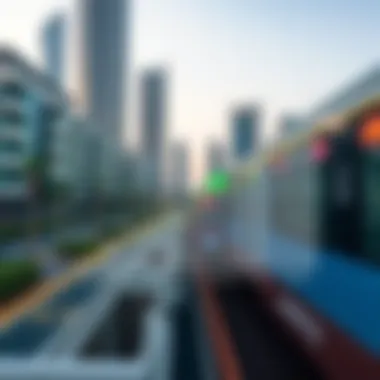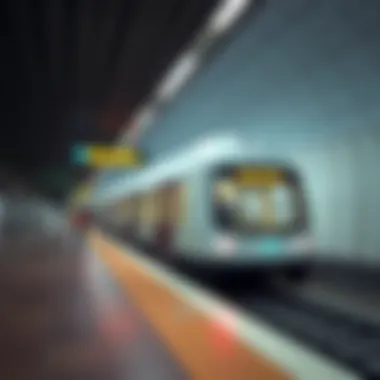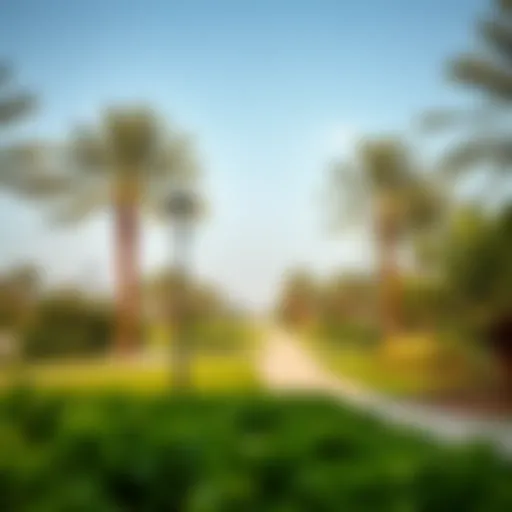Essential Overview of the Dubai Metro System


Intro
Dubai has rapidly transformed from a dusty trading port into a glistening metropolis, and at the heart of this vibrant city lies its sophisticated Metro system. A prime example of urban development, the Dubai Metro is not just a mode of transportation; it’s a vital entity influencing daily life, real estate scenes, and the overall urban experience. Understanding the layout and operations of the Metro can unlock the local nuances that make navigating this city intuitive and rewarding.
The Dubai Metro operates on two primary lines—the Red Line and the Green Line—each threading through key districts, business hubs, and tourist attractions. From the bustling Dubai Mall to the alluring Dubai Marina, the Metro connects residents and visitors to the places they need to be, often making it a more preferable option compared to navigating the bustling streets filled with traffic.
By diving deep into the details of the Dubai Metro map, individuals gain insights into commuting ease, the market dynamics surrounding properties near stations, and the whole landscape of urban mobility. Each station also represents a junction of potential investment opportunities, reflecting local real estate fluctuations in real time.
In this guide, we delve into the metrics of the Metro's impact on the market trends and property investment insights surrounding this metropolitan hub. Let's unfold this fascinating narrative while highlighting how the city’s railway system shapes the lives of investors, expats, agents, and property buyers alike.
Understanding the Dubai Metro
The Dubai Metro stands as a significant symbol of urban advancement, threading through the heart of one of the fastest-growing cities in the world. It's not merely a mode of transportation; it holds great importance for both residents and visitors, providing ease of movement in an otherwise bustling metropolis. Understanding how the Dubai Metro operates can greatly enhance one's experience of the city. For many investors, expats, and newcomers, delving into the functions and benefits of the metro system is crucial in navigating both the physical and cultural landscape of Dubai.
Overview of Metro Infrastructure
The Dubai Metro system consists of two primary lines: the Red Line and the Green Line. Together, they span more than 75 kilometers and encompass over 50 stations. This extensive network connects major hubs such as Dubai International Airport, the Mall of the Emirates, and the business district of Dubai Marina. The stations themselves are a blend of modern architecture and user-friendly design, featuring wide concourses and aesthetic artwork that offers glimpses into Emirati culture.
Key features of the Metro Infrastructure include:
- Automatic Train Operation: The trains are driverless, which enhances reliability and safety, allowing for efficient service.
- Advanced Technology: The metro employs the latest technology, including real-time information systems that keep passengers updated about train schedules and waiting times.
- Accessibility: Stations are equipped with facilities for disabled passengers, making the metro an inclusive option for all.
In addition to physical trains and stations, the logistics behind the metro's operation include a complex control system, ensuring smooth and timely journeys throughout the city.
Importance of the Metro System
The importance of the Dubai Metro system cannot be overstated, as it significantly impacts daily life in the city and serves multiple functions. For one, it alleviates congestion on the roads, providing a fast, efficient alternative to driving. Traffic in Dubai can be quite daunting, especially during peak hours, and the metro offers a way to sidestep the gridlock.
"The Dubai Metro has changed the way we move around the city; it's like having a personal express lane right across town."
Beyond just ease of travel, the metro system fosters environmental sustainability by encouraging public transportation over private vehicle use, subsequently reducing carbon emissions. This aligns with the broader goals of the UAE regarding green initiatives and sustainable urban development.
Here are some additional benefits of the Dubai Metro:
- Economic Growth: By improving accessibility, it enhances property values and stimulates economic activity around the metro stations.
- Cultural Connectivity: It promotes cultural exchange by making various attractions easily reachable, enabling tourists and residents to explore the city’s diverse offerings.
- Centralized Travel: The metro is designed to connect with other modes of transportation, such as buses and taxis, providing a seamless experience for users.
In essence, understanding the Dubai Metro is pivotal not only for navigating the city but also for appreciating how this system influences the broader dynamics of urban life, real estate markets, and environmental policies.
Detailed Metro Map Layout
The Dubai Metro Map stands as a pivotal tool for anyone navigating the city’s public transport landscape. This detailed layout not only shows the routes but also depicts how the metro system fits within the broader urban fabric of Dubai. Understanding this intricacy can enhance travel experience, making it both efficient and enjoyable. For newcomers and seasoned riders alike, grasping this map layout means unlocking the secrets of Dubai’s transit options.
One major benefit of familiarizing oneself with the detailed metro map layout is the immense ease it brings to travel planning. Without it, one might waste precious time trying to find their way through the city. Key connections and transfer points stand out when viewed on the map, providing clear guidance on how to best navigate from point A to point B. Riding the metro can certainly feel like hitting the jackpot when you’re in the thicker cities and looking to avoid traffic or parking issues. Moreover, this map illustrates connections to other transportation modes, like buses and water taxis, ensuring comprehensive transportation options are available for the various urban destinations.
Key Metro Lines Explained
The metro lines are numbered and color-coded, serving as essential arteries for the city’s movement. The Red Line and Green Line are the two primary lines, each catering to distinct sections of the city.
- Red Line: Stretching from Rashidiya in the east to UAE Exchange in the west, this line basically runs along Sheikh Zayed Road, which is the heartbeat of Dubai’s business district. The Red Line is bustling, particularly during peak hours, as it connects critical commercial centers and popular attractions like the Burj Khalifa and Mall of the Emirates.
- Green Line: This line runs a more straightforward path from Etisalat to Dubai Creek, weaving through neighborhoods and cultural hotspots. It serves local communities and connects with the Red Line at key transfer stations, making it vital for those looking to dive into the cultural side of Dubai.
Thus, knowing which line to take is crucial for effective navigation. The scheduling of metro services is frequent, with trains arriving at intervals that usually span about 2-7 minutes during peak times. So, this key detail cannot be overstated, as it cuts down on wait times and enhances overall travel efficiency.
Stations and Their Significance
Each metro station is more than just a stop; it's a microcosm reflective of the neighborhood it serves. The design, facilities, and even the artwork display a connection to the locale's spirit.
For instance, the Burj Khalifa/Dubai Mall station offers riders direct access to towering skyscrapers and retail experiences. Similarly, the Business Bay station catapults you into the heart of Dubai's bustling corporate sector. Notably, stations like Union serve as vital junctions where the two metro lines converge, making it a busy hub during commute hours.
Moreover, many stations have amenities such as convenience stores and dedicated waiting areas, catering to the needs of commuters. The structures themselves often reflect modern architectural trends, enhancing the city's aesthetic appeal.


Stations are the lifeblood of the metro system, acting as gateways to wider urban adventures.
As you explore, noting the significance of each station can add layers to your experience. Frequent travelers and expats alike find it helpful to discover not just how to navigate but also where each metro stop leads, ultimately aiding in daily life or while exploring the vibrant city.
Understanding the 'Detailed Metro Map Layout' is essential to not only optimizing travel efficiency but immersing yourself in what Dubai has to offer, making it an indispensable reference for anyone looking to explore this vibrant city.
Navigating the Metro System
Understanding how to navigate the Dubai Metro System is crucial for both new residents and visitors. The metro serves as the backbone of public transport in the city, offering a stress-free means of travel that connects essential locations and reduces traffic congestion on bustling roads. By mastering this system, one can save time and money while gaining a deeper appreciation for the city’s vast geography and cultural hotspots.
Transit Tips for New Riders
Navigating a new metro system can feel like a maze, especially in a vibrant city like Dubai. Here are some valuable tips to make the journey as smooth as silk:
- Familiarize Yourself with the Metro Map: Before you jump on board, take a moment to study the metro map. Knowing the layout, including the route lines (Red and Green) and key stations, will help you feel more at ease. The metro system spans both the downtown area and suburban districts, making exploration easy with some initial planning.
- Get an NOL Card: This card is your ticket to the city! Available at ticket vending machines in all metro stations, the NOL card allows you to pay for your rides with ease, eliminating the need to carry cash. It also offers discounted fares compared to single journey tickets.
- Mind the Timetable: Metro trains run every few minutes, but it’s wise to consult the schedule, especially if you’re commuting during off-peak hours or late at night. Knowing the hours of operation can prevent unexpected delays.
- Plan Your Transfers: Some journeys may require transferring between lines. Understanding where these crosspoints are located and how to navigate them can greatly reduce travel time.
- Download the Dubai Metro App: The official app provides real-time updates on train schedules, service alerts, and even guides you to nearby stations. It’s a handy tool for anyone moving around the city.
By implementing these tips, first-time riders can embark on their journey through Dubai’s metro system with confidence and ease.
Metro Etiquette and Policies
While riding the metro is convenient, adhering to proper etiquette ensures a pleasant experience for everyone. Here are some key pointers to keep in mind:
- Prioritize Seating for Those in Need: Reserved seats are available for the elderly, disabled, and pregnant women. Always offer your seat if you see someone who would benefit from it.
- Keep Noise Levels Down: Whether you’re on a phone call or engaging in conversation, keep your voice low. Many passengers prefer to enjoy a quiet journey.
- Avoid Eating and Drinking: Eating or drinking during your ride could lead to messiness and discomfort for other passengers. It’s best to consume food and beverages before or after your journey.
- Be Mindful of Personal Space: During peak hours, trains can be crowded. Respecting personal space, not pushing, and allowing everyone to board and disembark in an orderly fashion is vital.
- Follow Signage and Announcements: Each metro station and train offers clear signage. Pay attention to announcements regarding stops, safety instructions, and any temporary service changes.
Following these simple etiquettes ensures everyone has a pleasant and respectful riding experience.
As you gear up to navigate the Dubai Metro, equip yourself with these insights and best practices to enhance your journey. Mastery of the metro not only aids in traversing the city's myriad attractions but also fosters a deeper connection with the bustling life that Dubai exudes.
Impact of the Metro on Real Estate
The introduction of the Dubai Metro has changed the real estate landscape in the city. It serves as a vital component of urban mobility, thus significantly influencing property values and investment patterns. By providing efficient transportation, the Metro not only eases daily commutes but also enhances accessibility to various neighborhoods and business districts. For investors, expats, and buyers, understanding the effects of the Metro on real estate is crucial to making informed decisions.
Property Values Near Metro Stations
The proximity of residential and commercial properties to metro stations tends to elevate their market value. Essentially, being closer to public transport options equates to greater convenience, and people are generally willing to pay a premium for it. Numerous studies have shown that properties located within a half mile radius of metro stations experience faster appreciation in value compared to those further away.
For instance, areas such as Dubai Marina and Business Bay, which are serviced by metro lines, have witnessed property values soar due to their strategic location. Potential buyers are not just looking for a roof over their head; they desire accessibility. Properties offering easy transit to workplaces, shopping hubs, and leisure facilities tend to attract greater interest, which naturally drives their prices up.
Additionally, the rental market sees heightened demand near metro stations, which means investors can command higher rental yields. Those keen on securing long-term rentals often seek locations near transit, knowing it adds undeniable value to their living experience.
"Location, location, location. It’s the golden rule in real estate, and transport connectivity is becoming a key part of that equation."
Trends in Property Investment
The dynamics of property investment in Dubai are closely linked to the expansion and operation of the Metro. As new stations open and service areas expand, investors often shift their focus to newly accessible zones. This creates opportunities for capitalizing on emerging hotspots, turning previously overlooked neighborhoods into sought-after locations.
Key trends include a growing interest in mixed-use developments around metro stations. These complexes not only house residential units but also feature commercial spaces, turning them into vibrant communities where people can live, work, and play without needing long commutes. This holistic approach to urban planning makes such developments appealing.
Furthermore, sustainability is playing a more prominent role in investment decisions. With the Metro promoting a reduction in vehicular traffic and carbon emissions, properties marketed as transit-oriented become attractive options for eco-conscious investors. As global attitudes toward sustainability shift, investors are adapting, resulting in a visible increase in demand for properties that are easily accessible via public transport.
Summarizing, the impact of the Dubai Metro on real estate cannot be overstated. For potential homebuyers and investors alike, understanding these nuances can lead to smarter investments and a better understanding of the city's evolving landscape.
Future Developments of the Metro
The ongoing evolution of the Dubai Metro system plays a pivotal role in shaping the future of the city’s urban infrastructure. Not only does it serve as a backbone for public transportation, but also as a catalyst for real estate growth and community connectivity. This section delves into the upcoming developments designed to expand and enhance the metro network, ensuring it meets the demands of an ever-growing population.
Upcoming Station Extensions
One of the most notable projects on the horizon is the extension of existing metro lines. The anticipated expansions include adding new stations on the Red and Green Lines, which will improve accessibility for residents and visitors alike. These extensions are being planned for several key areas, especially those experiencing rapid urbanization.


- A key focus area is the Dubai marina, where new stations will likely ease congestion and facilitate better access to the waterfront and entertainment venues.
- The Al Maktoum International Airport station is another highly awaited addition, which can streamline travel for commuters and tourists.
These upcoming station expansions are crucial for various reasons:
- Improved Commute: Shortening travel times will make life easier for many.
- Increased Property Demand: With new stations, property values in these areas may see a significant uptick as demand grows.
- Enhanced Environment: More accessible public transport can ultimately encourage residents to opt for metro travel over car usage, leading to fewer vehicles on the road, which is beneficial for reducing traffic congestion and pollution.
Investors are particularly keen on these developments, as they may signal a surge in property transactions and rental prices in the vicinity of newly launched metro stations.
Integration with Other Transport Systems
The integration of the Dubai Metro with other existing public transport systems is a game changer for residents and tourists. This multi-modal transport approach is designed to provide seamless travel experiences across the city. Here's how the integration is taking shape:
- Tram Systems: Connections with the Dubai Tram system are being fortified, allowing passengers to transition smoothly between different modes of transport.
- Buses and Ferry Services: Enhanced coordination with bus networks and ferry services will ensure comprehensive coverage throughout the metropolitan area.
- Smart Transport Solutions: The integration of smart technology means that transport users can easily check transfer times and plan their travel efficiently.
Benefits of such integration are manifold:
- Convenience: Travelers will find it easier to navigate across various transport modes with a single payment system.
- Cost-Effective Travel: Users could potentially save money with integrated fare options that offer discounts for multi-modal journeys.
- Urban Mobility: Enhanced connectivity leads to a well-functioning urban network, catering to the needs of an increasingly mobile population.
As such, the future of the Dubai Metro is not merely about expanding the tracks but also about creating an interconnected travel ecosystem.
By understanding and adapting to these developments, investors, agents, and expatriates can make well-informed decisions about property investments and lifestyle in Dubai.
For more detailed insights and updates on the Dubai Metro, it's worth checking out resources like Dubai's Roads and Transport Authority and community discussions on platforms such as Reddit and Facebook Groups.
Traveling Tips for Foreign Residents
Navigating a foreign transport system can often feel like trying to solve a Rubik's Cube blindfolded. This section illuminates essential traveling tips for foreign residents using the Dubai Metro, ensuring that newcomers smoothly transition into their urban journey. Understanding how to best utilize this robust network not only enhances the commuting experience but also serves as an invaluable tool for exploring the city.
Understanding Fare Structures
When assessing the cost of using the Dubai Metro, it's imperative to comprehend the fare structure. Fares are determined based on the distance traveled and are categorized into zones. Each passenger pays according to how many zones their route crosses, which can range from a single trip fare to daily passes that offer unlimited travel.
For instance, a short trip from one side of a zone to another might only cost AED 3, while longer journeys can climb to AED 8 or more, depending on the zones traversed. Here are some key points to consider:
- Nol Cards: Residents should invest in a Nol Card, which operates as a prepaid travel card accepted on the Metro, buses, and even water taxis.
- Types of Nol Cards: Different categories of cards cater to various needs:
- Daily Passes and Monthly Passes: For frequent travelers, consider purchasing a daily pass that allows unlimited travel within all zones.
- Red Ticket: Ideal for short-term travelers, can be used for up to ten rides.
- Silver Card: A smart option for regular users, loaded with balance for multiple trips.
- Gold Card: A premium option that offers first-class travel experience for a higher fare.
All fares are conveniently displayed at ticket kiosks and on the Dubai Roads and Transport Authority’s (RTA) website for easy reference: RTA.
Using Metro for Local Tourism
The Dubai Metro is not just a mode of transport; it’s a vehicle for exploration. Linking major attractions, the Metro provides foreign residents with a delightful way to uncover local gems without breaking the bank. Here are several ways to leverage the Metro for tourism:
- Key Attractions Along the Metro Lines: Several iconic sites are within walking distance from stations. The Burj Khalifa/Dubai Mall Station connects travelers to one of the tallest buildings in the world and a shopper's paradise. The Dubai Marina Station provides access to picturesque waterfront views and a myriad of dining options.
- Central Hub: The Metro effectively becomes a central hub from which residents can plan trips. This feature is particularly appealing for those looking to explore various neighborhoods throughout the city without the headache of navigating through traffic.
- Cost-Effectiveness: Taking the Metro is more than just convenient; it’s economical too. Bypassing the expensive taxi fares can save a significant sum, especially when planning multiple stops in a day.
- Cultural Insights: Riding the Metro allows you to interact with locals and fellow travelers, offering an inside look at the diverse cultural tapestry of Dubai. Sit back and take note of the breathtaking artwork displayed in select stations, which reflects the city’s rich heritage.
Using the Dubai Metro for local tourism not only aids in planning an efficient itinerary but also enables foreign residents to absorb the vibrant essence of the city.
"Traveling through the metro gives you the pulse of Dubai; that's where you find the heartbeat of the city!"
Adopting these practical habits will prepare foreign residents to make the most of their Metro experience, transforming everyday commutes into extraordinary adventures.
Sustainability and the Metro
Sustainability has become a cornerstone in urban planning, and the Dubai Metro stands as a prime example of how public transport can contribute to greener cities. In an ever-increasingly urbanized world, finding ways to reduce environmental impacts while still catering to growing populations is imperative. The Metro, by design, aims not just to move people, but to do so with a mindful approach towards the ecosystem and community well-being.
Green Initiatives in Metro Operations
The Dubai Metro has implemented several green initiatives to ensure that its operations align with sustainable practices. Notable efforts include:


- Energy Efficiency: The trains are equipped with regenerative braking systems, which recycle energy during stops, feeding it back into the power supply. This cuts down on energy consumption significantly.
- Solar Power Utilization: Solar panels are integrated into some stations, harnessing the sun's energy to power lighting and other systems within the metro network.
- Water Conservation: Stations have adopted water-saving technologies, reducing water waste without compromising service quality. This is crucial in a region where water scarcity is a concern.
- Sustainable Materials: The construction and maintenance of the Metro have focused on utilizing sustainable materials, promoting recycled and eco-friendly options wherever possible.
- Waste Management: The Metro complies with strict waste management protocols, including recycling programs to minimize landfill contributions.
These green initiatives reflect a commitment to environmental welfare, while also potentially cutting operational costs in the long term.
Metro’s Role in Reducing Carbon Footprint
As urban populations burgeon, reducing greenhouse gas emissions becomes increasingly vital. Public transport like the Dubai Metro plays a key role in achieving lower emissions per capita. By shifting commuters from personal vehicles to trains, the Metro effectively decreases road congestion and lowers overall carbon output.
"Public transit like the Metro is not just about convenience; it’s a step towards lowering the collective carbon footprint of the city."
Benefits of the Metro's Role Include:
- Reduction in Vehicle Emissions: With more people choosing to ride the Metro instead of driving, there's a marked decrease in pollutants released into the atmosphere.
- Promoting Commuter Efficiency: The availability of reliable transit options encourages less dependency on individual cars, lowering overall energy consumption.
- Support for Kid-Friendly Development Projects: As the Metro expands, it inspires urban development to be more family-friendly, fostering areas that prioritize public transport over car-centric designs.
Cultural Significance of the Metro
The cultural fabric of a city often weaves through its public transit systems, and Dubai’s Metro is no exception. More than just a means to get from point A to B, the Metro serves as a vibrant artery that connects dense urban neighborhoods, showcasing the diverse tapestry of its inhabitants. The significance of the Metro in Dubai goes far beyond its practical usage; it stands as a symbol of modernization, inclusivity, and a place for daily social interactions among its riders.
Art and Architecture within Metro Stations
One can’t help but notice the stunning art and architecture that grace the interior of Dubai's Metro stations. Each station is often regarded not merely as a transport hub but as a canvas for creativity. For instance, the Burjuman Station showcases intricate Islamic design motifs that resonate with the city’s cultural heritage.
The use of natural light in places like the Dubai Healthcare City Station creates a welcoming atmosphere, while the incorporation of modern technology aligns seamlessly with Dubai’s vision for a high-tech future. The art installations, typically sourced from local artists, enable the Dubai Metro to foster a sense of pride amongst its citizens.
Some key artistic features include:
- Local Artists’ Showcase: Rotating exhibitions in stations highlight the work of Emirati and expatriate artists alike.
- Thematic Design: Each metro line often reflects a particular theme, encapsulating different aspects of Dubai’s rich history.
- Public Art Projects: Artsy collaborations convert stations into galleries, enhancing the aesthetic appeal of daily commutes.
The architectural prowess and thoughtful artistic choices in the Metro stations make them landmarks in their own right, often serving as reminders of Dubai’s commitment to blending traditional aesthetics with contemporary engineering.
Social Interactions in the Metro Environment
In terms of social fabric, the Metro exemplifies an inclusive environment where people from all walks of life converge. Commuters range from seasoned expats to local Emiratis, creating a dynamic social tapestry. The social interactions that take place within the confines of a metro train can be quite enlightening. Conversations spark between strangers and the diverse blend fosters moments of cultural exchange.
One notable aspect of these interactions is the way they cultivate communal experiences. Commuters often share stories, tips about navigating the city, and even personal experiences that contribute to the narrative of daily life in Dubai. It’s not unusual to see individuals helping each other out with directions or engaging in light banter, showcasing the spirit of camaraderie that transcends language barriers.
Moreover, special events and campaigns such as “Metro Moments” encourage passengers to capture and share their experiences on social media platforms. Such initiatives not only bridge gaps between diverse cultures- but also celebrate the unique identity of Dubai.
“Every ride is a new encounter, a new story waiting to unfold.”
In summary, the cultural significance of the Dubai Metro lies in its ability to meld art with daily life while fostering social cohesion. It serves as a reminder of how urban infrastructures can manifest deeper cultural narratives, ultimately shaping the lifestyle of a city that prides itself on its diversity and modernity.
User Experience Insights
Understanding user experience within the Dubai Metro system is crucial for both commuters and the city’s overall urban planning strategy. When riders feel comfortable and supported during their travels, it translates into increased metro usage, thus fostering a thriving public transport culture. Moreover, well-rounded experiences contribute to the metro's reputation and can sway potential investors or residents to view the area as a desirable living environment.
Several critical elements influence user experiences, such as punctuality, cleanliness, accessibility, and overall service consistency.
Passenger Feedback and Improvements
Passenger feedback is the lifeblood of any public transportation network, and the Dubai Metro is no exception. The insights provided by daily commuters are instrumental in fine-tuning services, improving facilities, and addressing pain points.
- Mobile Apps: Users can share their thoughts through mobile applications designed specifically for the metro. This feedback helps authorities monitor real-time issues and respond quickly.
- Surveys: From time to time, surveys are conducted to gather broader insights into user satisfaction. Topics vary from train cleanliness to station ambiance.
- Social Media Presence: The Dubai Metro maintains active communication channels on platforms like Facebook and Twitter, engaging passengers and responding to inquiries. This transparency cultivates trust and keeps everyone informed of any changes to services.
One noteworthy improvement based on feedback was the expansion of services during peak hours. Riders have pointed out that the frequency of trains during morning and evening rush hours was insufficient. In response, additional trains were added to alleviate congestion.
Comparative Analysis with Global Metro Systems
When comparing the Dubai Metro to other global metro systems, such as the London Underground or Tokyo Metro, we can identify several key differences and similarities. Evaluating these aspects sheds light on how Dubai's approach meets both local and global standards.
- Efficiency: The Dubai Metro is known for its punctuality with an impressive average wait time between trains. This has been a consistently praised point among users.
- Technology: Many cities are now integrating smart technology into their metro systems. In this arena, the Dubai Metro stands out with its automatic train operations and user-friendly mobile applications, offering real-time updates.
- Cleanliness and Maintenance: The metro system in Dubai prides itself on being spotless compared to many other cities. Regular cleaning schedules and upkeep of facilities reflect positively on rider experiences.
"A ride on the Dubai Metro is not merely a journey from Point A to Point B; it’s an experience shaped by convenience, safety, and technological sophistication."
In summary, user experience insights are vital for assessing the effectiveness and attractiveness of the Dubai Metro system. Through attentiveness to passenger feedback and a careful look at how the metro stands in relation to other international systems, stakeholders can better understand and improve this critical component of urban infrastructure.











